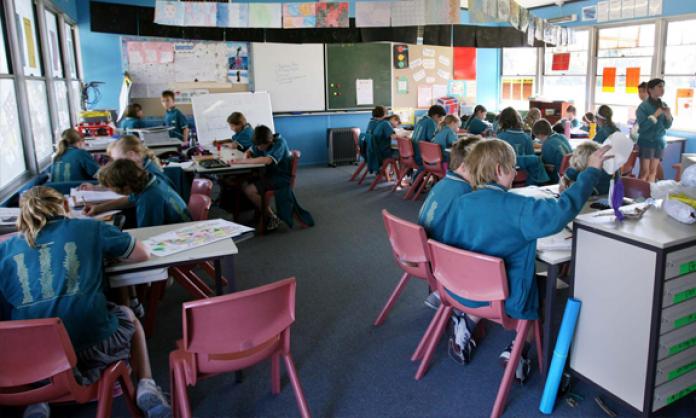Days after announcing that they want to gut university funding by $2.8 billion a year, Malcolm Turnbull and education minister Simon Birmingham unveiled their plan for school funding. Dubbed “Gonski 2.0”, the new school funding plan, according to the Liberals, will mean an “extra” $18.6 billion over the next decade. This is $22 billion less than the plan under the previous Labor government. Queensland public schools will be $300 million worse off than under Labor’s original plan.
While the media have devoted much coverage to the aspects of the scheme that will that slow funding increases to 350 Catholic and independent schools and cut funding to 24 private schools, the private school sector as a whole will again win big from the new arrangement.
Caulfield Grammar in Melbourne’s south-east, which charges fees of $29,000 a year, will be $34.8 million better off over the next decade. The King’s School in Parramatta, which charges $34,000 a year, will receive $19.3 million in additional funds by 2027. Scots College in Malcolm Turnbull’s electorate of Wentworth will receive an additional $10 million over the same period.
Along with trying to impose a massive cut to overall funding, Turnbull and Birmingham’s scheme includes a series of attacks on teachers’ conditions and education quality. The government has launched a new review headed by David Gonski into how education funding is to be spent. If the government’s Quality Schools, Quality Outcomes manifesto is any indication, the review will recommend that any additional funding come with considerable strings attached.
Released in 2016, Quality Schools, Quality Outcomes argues for expansion of the existing standardised testing regime and the introduction of performance pay for teachers. Performance pay structures will harm the take-home pay of thousands of teachers and foster competition where there should be collaboration and resource sharing. “Accountability” measures will mean more school funding being spent on management and bureaucratic monitoring and reporting systems.
The Liberals also want NAPLAN-style literacy and numeracy tests for every single year of school, and a phonics test for year 1 students. Given that the initial roll-out of NAPLAN led to the widely hated MySchools website, which ranks schools based on “performance”, there can be no doubt that the addition of further standardised testing will mean the results being tied to further funding. Birmingham has also indicated that the government wants publicly available data about schools to include data about teachers.
In a political coup for Turnbull, David Gonski, the architect of Labor’s funding model, has come on board to back the Liberals’ plan. Teachers’ unions – including the Queensland Teachers’ Union, which vocally supported the ALP’s Gonski model during the last two election cycles – are now questioning Gonski’s suitability to review education spending.
Gonski’s credentials show how dangerous it was for unions to place their faith in someone of his ilk. Gonski started his career as a lawyer and rose through the ranks to become the youngest ever partner at Freehills law firm, which would would later construct John Howard’s WorkChoices laws. After leaving Freehills, he went on to establish an investment bank and topped the Australian Financial Review’s corporate power list in 2016. It tells more about the Labor Party that it would select Gonski to chair its panel on school funding than it does about his apparent about-face to join the side of the Liberals.
Gonski under Labor
What was wrong with the original Gonski funding model was not that it was made up of 27 different agreements with states, territories and school sectors. What was wrong was that it maintained taxpayer funding for Australia’s private school system. The Australian private school sector receives more public money than in most countries in the OECD. Julia Gillard’s plan ensured that public funds would continue to flow to these elite schools.
Additionally, the first Gonski plan staggered its funding increases, meaning that the largest injections of funds were scheduled for 2018-19, years 5 and 6 of the model, while the initial roll-out resulted in a funding decline. Analysis in 2013 by Fairfax Media showed that despite Gillard’s claims of a multi-million dollar pledge, the school funding changes delivered the government a budget saving in two of the program’s first three years. Schools were $21 million worse off in 2014-15 and $136 million worse off in 2015-16 compared to what had been forecast before Gonski.
What’s needed
In a positive step, the QTU has foreshadowed a boycott of a year 1 phonics test. Refusing to implement the successive literacy and numeracy tests is also a must, but we’ll need to go much further to turn the tide on school funding. Declining public school funding, more money going to private schools, performance pay for teachers and increased competition between schools must be reversed.
It’s clear that teachers and students cannot sit back and wait until the next federal election to vote the Liberals out. These cuts need to be stopped now. The government’s plan represents a serious challenge, but it could also be a chance to reinvigorate our unions if we fight these reforms through collective action.








